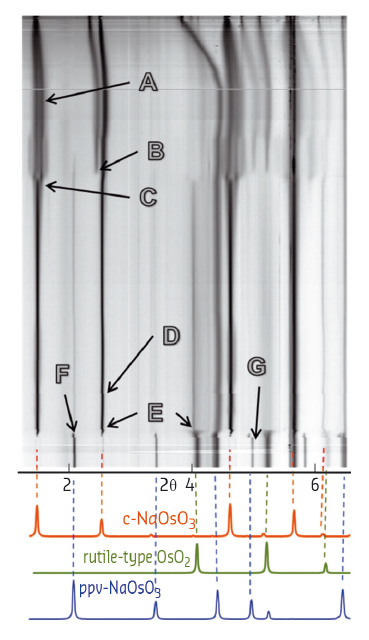- Home
- Users & Science
- Scientific Documentation
- ESRF Highlights
- ESRF Highlights 2016
- Matter at extremes
- A new route to pentavalent post-perovskite
A new route to pentavalent post-perovskite
The postperovskite form of NaOsO3 can be synthesised from the known perovskite form at pressures in excess of 16 GPa. Also, this new postperovskite can be more advantageously grown from a lower pressure KSbO3-type at less than 6 GPa. In situ X-ray diffraction using the ID06 large volume press was instrumental in these studies.
The 5d compounds have fascinating properties that can be adopted for spintronics and other advanced electronic technologies. In recent years, a variety of new compounds have been isolated in the Na-Os oxide system. These include the high-pressure production of pentavalent, hexavalent and heptavalent compounds, all of which we have observed in the course of this study. The pentavalent NaOsO3 stoichiometry has been previously described as a KSbO3-type and a perovskite [1,2]. These KSbO3-type structures are, generally, a family of tunnel-containing compounds that exhibit a range of chemistries and a plethora of attractive physical properties; including ionic conduction, catalytic activity and oxygen sensing. The wider KSbO3 family also support great flexibly in their chemistries. This, combined with the wide range of valences available in the Na-Os-O system, makes them an ideal system for exploring new synthetic protocols that can exploit changes in oxidation state and bulk chemistry to produce novel phases.
Such in situ synthetic work at high pressures and temperatures is rather complex and we have sought to overcome some of the technical difficulties by first pre-synthesising two samples offline, in Pt capsules, at 6 GPa. We have used two near-identical schemes that incorporate the same nominal mixtures of 1:1 Na2O2:OsO2 with excess oxygen source, from sodium peroxide, to produce perovskite and KSbO3-type-rich initial starting materials.
In a first run, using the large-volume press at beamline ID06LVP, a single phase sample of perovskite (pv) NaOsO3, was pressurised up to 16.35 GPa and the temperature increased. At 1135 K, inspection of the changed diffraction profiles readily demonstrated the formation of CaIrO3-type ppv-NaOsO3. This was quite unexpected as many structural indicators are completely against pv-NaOsO3 forming post-perovskite (ppv); for example, its lattice parameters at ambient conditions (Pnma; Z = 4, a = 5.3830(3), b = 7.5763(4), c = 5.3245(3) Å) are closer to pseudocubic, Φ = 10.55º, than are normally considered sufficient to lead to the crystallisation of ppv at high P. The tolerance factor is also higher than t = 0.9 (at t = 0.924), as is the ratio of polyhedral volumes, VA/VB = 4.82, which are both well above normal cut-offs for pv to ppv transitions. Assuming a dP/dT slope of 10-17 MPa/K, and that the synthesis is representative of an equilibrium transformation, this would place the room temperature transition at less than 5 GPa.
 |
|
Fig. 126: A series of semi-continuous X-ray diffraction patterns collected upon pressurising and during two heating-cooling cycles. Shown is the lower angle part only. Of note: (A) Increased splitting of the (110/1-10) pair; (B) Loss of NaO2OsO4; (C) rR to c-NaOsO3 transformation; (D) Quench, end heating cycle 1 (E) 's'-shaped-kink, onset of OsOO2 and crystallisation of ppv (F). (G) Quench end of heating cycle 2, followed by reheat. Simulated diffraction patterns for c-NaOsO3, OsO2 and ppv-NaOsO3 are shown as key. |
Using the less dense and alternate KSbO3-type rich sample, at 6.05 GPa, Figure 126, A, the secondary Na2OsO4 phase (due to Na2O2 excess) is consumed into the single-phase rhombohedrally distorted KSbO3-like phase at 750 K, Figure 126, B. Immediately after this, a continuous transformation from rR to c-NaOsO3 is observed (830 K), Figure 126, C. From these results, higher temperatures and lower pressures favour the crystallisation of the Pn-3 type KSbO3-form over the rhombohedral distortion. With further heating, following intermediate quench (D), we evidence two almost coincident events: (i), at 750 K, the sharp ‘s’-shaped kink in the c-NaOsO3 peaks (E) that occur with the growth of rutile-type OsO2 and, (ii) at 825 K, F, the growth of ppv-NaOsO3. The rapid peak-shift to lower d-spacing of all cubic peaks and concomitant growth of OsO2 is indicative of a reduction of lattice size, with presumably, loss of Os to its rutile-structured oxide. Ppv crystallises immediately after. At conversion, the lattice of ppv is a = ;2.8192(17) Å, b = 10.4047(21), c = ;7.3179(18) Å (V/Z = 53.66 Å3/f.u.); with c-NaOsO3 at a = 9.0709(7) Å (V/Z = 61.20 Å3/f.u.) and their relative volume difference is ∆V = -12.3%. A recovered sample, quenched at point G, shows fine-grained texture for the ppv, while the minor KSbO3-like phase is spotty and has reverted to a new rhombohedral distortion.
From this alternative route, we observe that i) pv-NaOsO3 can be advantageously formed from an assemblage that does not yet contain any pv, ii) ppv can be formed from phases other than pv (even in systems where pv occurs) and iii) the growth of pv as a precursor or indicator to ppv is counterproductive, requiring more than 10 GPa higher pressure to initiate the transformation. The difference in volumes of >10% (KSbO3-type to ppv) compared to just 1-2% for pv-ppv at transformation no doubt influences this. From both NaIrO3 and NaOsO3, limits in both pseudocubic tilt and tolerance factor could be reassessed to include more pentavalent chemistries.
Principal publication and authors
An alternative route to pentavalent post-perovskite, W.A. Crichton (a), K. Yusenko (b), S. Riva (b), F. Mazzali (b) and S. Margadonna (b), Inorganic Chemistry 55, 5738-5740 (2016); doi: 10.1021/acs.inorgchem.6b00780.
(a) ESRF
(b) College of Engineering, Swansea University (U.K.)
References
[1] A.W. Sleight et al., J. Solid State Chem. 183, 402 (2010).
[2] Y. Shi et al., Phys. Rev. B 80, 1661104 (2009).



